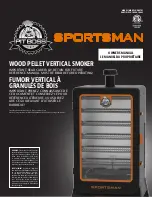
Copyright
©
2011 SMC Networks
Page 1
All Rights Reserved
SMC Smoke Detector Guide
Congratulations on purchasing your SMC Smoke Detector
1
Models
I/M SMCSMXX-Z rev. 2.0
7/26/11
The SMC Smoke Detector comes in two versions:
¾
SMCSM01-Z
¾
SMCSM02-Z
2
Parts List
¾
One SMC Smoke Detector
¾
One dust cover
¾
Two CR123A lithium batteries
¾
Mounting bracket
¾
This guide
If any items are missing or damaged, contact
your place of purchase. Keep the carton,
including the original packing material, in case
you need to store or return the product.
3
Specifications
Voltage: 3
VDC
Battery Type:
(2) 3V Lithium, Duracell® 123,
Sanyo® or Panasonic® CR123A
Sensitivity:
2.25 % ± 1.35 %
Drift Compensation Adjustment:
0.5%/ft. max
Operating Temperature:
40° to 100° F (4.4° and 37.8° C)
Compatible Control Panel:
RB5701-Z TouchScreen
4
NFPA Guidelines
The SMCSMXX-Z Smoke Detector family is designed to be used with a TouchScreen as part of the Fire and Life Safety signaling device. The SMCSMXX-Z has an
optical sensor capable of detecting smoke particles in the event of fire. It also contains an integrated heat sensor that is triggered if a room experiences a sharp
rise in temperature in the event of fire.
¾
NFPA 72, 2-1.4.2.1 Total (Complete)
Coverage
If required, total coverage shall include all
rooms, halls, storage areas, basements,
attics, lofts, spaces above suspended
ceilings, and other subdivisions and
accessible spaces; and the inside of all
closets, elevator shafts, enclosed stairways,
dumbwaiter shafts, and chutes. Inaccessible
areas shall not be required to be protected
by detectors. (For exceptions, see NFPA 72.)
¾
NFPA 72, 2-1.4.2.2 Partial Coverage
If required, partial detection systems shall
be provided in all common areas and work
spaces, such as corridors, lobbies, storage
rooms, equipment rooms, and other
tenantless spaces in those environments
suitable for proper detector operation in
accordance with this code.
¾
NFPA 72, 2-1.4.2.3 Selective Coverage
Where codes, standards, laws, or authorities
having jurisdiction require the protection of
selected areas only, the specified areas shall
be protected in accordance with this code.
¾
NFPA 72, 2-1.4.2.4 Supplementary (Non
required) Coverage
Where installed, detection that is not
required by an applicable law, code, or
standard, whether total (complete), partial,
or selective coverage, shall conform to the
requirements of this code. (For exceptions,
refer to NFPA 72 Chapter 2 Spacing
Requirements.)
¾
NFPA 72, 2-1.4.3
Where non-required detection devices are
installed for a specific hazard, additional
non-required detection devices shall not be
required to be installed throughout an entire
room or building.
¾
NFPA 72, 2-2 Heat-Sensing Fire Detectors
Heat-sensing fire detectors shall be installed
in all areas where required by the NFPA
codes and standards or by the authority
having jurisdiction.
¾
NFPA 72, 8-1.4.1.3.2 Detection in New
Apartment Buildings
Approved, single-station smoke alarms shall
be installed in accordance with 7-6.2.10 of
NFPA 101 outside every sleeping area in the
immediate vicinity of the bedrooms and on
all levels of the dwelling unit including
basements. (101: 18-3.4.4.2) (For
exceptions, refer to this section of NFPA
72.)
¾
NFPA 72, 8-1.4.1.4.2 Detection in Existing
Apartment
Buildings Approved, single-station smoke
alarms shall be in-stalled in accordance with
7-6.2.10 of NFPA 101 outside every sleeping
area in the immediate vicinity of the
bedrooms and on all levels of the dwelling
unit including basements. (101: 19-3.4.4.1)
(For exceptions, refer to this section of
NFPA 72.)
continued on next page



























